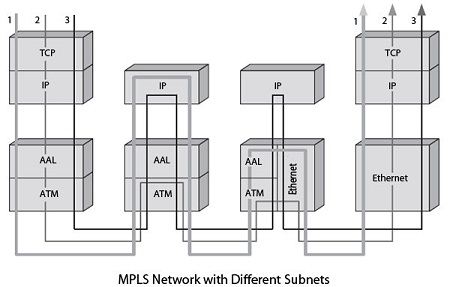MPLS (MultiProtocol Label-Switching) is a standard proposed by IETF, the Internet standards body for all architectures and high-level protocols (IP, IPX, AppleTalk, etc.). However, his most typical implementation concerns the IP protocol only.
The specific transfer nodes used in MPLS are called LSR (Label Switched Router). The LSR act as switches for user data streams and as routers for signaling. To route user frames, use references or labels. At an input reference is a reference output. The succession of reference defines the route followed by all frames containing the stream of IP packets.
Any frame used in switching or label-switching, can be used in an MPLS network. The reference is placed in a specific field of the frame or in a field added for this purpose.
MPLS Features
MPLS is the logical culmination of all the proposals that were made in the 1990s of the IETF The idea was to propose a common standard for transporting IP packets over subnets working in switched mode. The nodes are switch-capable routers back or at the IP level for performing routing, either at frame level for switching.
The most important features of the MPLS standard are as follows:
• Specify the mechanisms for transporting IP packet streams with various grain sizes of the waves between two points, two machines or two applications. Granularity refers to the size of the stream, which may include more or fewer user waves.
• Independence of the frame level and the packet level, although only transport IP packets to be really taken into account.
• Linking the IP address of the recipient with an input reference in the network.
• Recognition by the edge routers of the type of OSPF routing protocols and signaling such as RSVP.
• Use of different types of frames.
Some additional features are worth noting:
• Opening the path based on the topology, although other possibilities are also defined in the standard.
• Assignment of references made by the downstream, that is to say, at the request of a node issues a message in the direction of the transmitter.
• Granularity variable references.
• Stock references managed according to “last in, first served” method.
• Ability to prioritize requests.
• Use of TTL timer.
• Encapsulation of a reference in the frame including a TTL and a quality of service .

The main advantage provided by the MPLS protocol is the possibility, illustrated in Figure, to transport IP packets on several types of switched networks. It is thus possible to switch from an ATM network to an Ethernet network or a frame relay network. In other words, it may be any type of frame from the time reference can be included.
 Dinesh Thakur holds an B.C.A, MCDBA, MCSD certifications. Dinesh authors the hugely popular
Dinesh Thakur holds an B.C.A, MCDBA, MCSD certifications. Dinesh authors the hugely popular